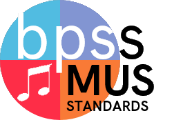BPS Music Standards Book
K-8 General Music
Grade 02
Young children arrive in Second Grade with widely varying knowledge in ....
2nd Grade Music "I can ... statements"
MUS-02.Cr - Creating
- MUS-02.Cr.01: Anchor Standard 1 - Generate and conceptualize artistic ideas and work
- MUS-02.Cr.01.1a: Improvise rhythmic and melodic patterns and musical ideas for a specific purpose.
- MUS-02.Cr.01.1b: Generate musical patterns and ideas within the context of a given tonality (such as major and minor) and meter (such as duple and triple).
- MUS-02.Cr.02: Anchor Standard 2 - Organize and develop artistic ideas and work.
- MUS-02.Cr.02.1a: Demonstrate and explain personal reasons for selecting patterns and ideas for music that represent expressive intent.
- MUS-02.Cr.02.1b: Use iconic or standard notation and/or recording technology to combine, sequence, and document personal musical ideas.
- MUS-02.Cr.03: Anchor Standard 3 - Evaluate, refine and complete artistic work.
- MUS-02.Cr.03.1a: Interpret and apply personal, peer, and teacher feedback to revise personal music.
- MUS-02.Cr.03.2a: Convey expressive intent for a specific purpose by presenting a final version of personal musical ideas to peers or informal audience.
MUS-02.Pr - Performing
- MUS-02.Pr.04: Anchor Standard 4 - Select artistic work for presentation
- MUS-02.Pr.04.1a: Demonstrate and explain personal interest in, knowledge about, and purpose of varied musical selections.
- MUS-02.Pr.04.2a: Demonstrate knowledge of music concepts (such as tonality and meter) in music from a variety of cultures selected for performance.
- MUS-02.Pr.04.2b: When analyzing selected music, read and perform rhythmic and melodic patterns using iconic or standard notation.
- MUS-02.Pr.04.3a: Demonstrate understanding of expressive qualities (such as dynamics and tempo) and how creators use them to convey expressive intent.
- MUS-02.Pr.05: Anchor Standard 5 - Develop and refine artistic techniques and work for presentation.
- MUS-02.Pr.05.1a: Apply established criteria to judge the accuracy, expressiveness, and effectiveness of performances.
- MUS-02.Pr.05.1b: Rehearse, identify and apply strategies to address interpretive, performance, and technical challenges of music.
- MUS-02.Pr.06: Anchor Standard 6 - Convey meaning through the presentation of artistic work.?
- MUS-02.Pr.06.1a: Perform music for a specific purpose with expression and technical accuracy.
- MUS-02.Pr.06.1b: Perform appropriately for the audience and purpose.
MUS-02.Re - Responding
- MUS-02.Re.07: Anchor Standard 7 - Perceive and analyze artistic work
- MUS-02.Re.07.1a: Explain and demonstrate how personal interests and experiences influence musical selection for specific purposes.
- MUS-02.Re.07.2a: Describe how specific music concepts are used to support a specific purpose in music.
- MUS-02.Re.08: Anchor Standard 8 - Interpret intent and meaning in artistic work
- MUS-02.Re.08.1a: Demonstrate knowledge of music concepts and how they support creators'/ performers' expressive intent.
- MUS-02.Re.09: Anchor Standard 9 - Apply criteria to evaluate artistic work.
- MUS-02.Re.09.1a: Apply personal and expressive preferences in the evaluation of music for specific purposes.
MUS-02.Cn Connecting
- MUS-02.Cn.10: Anchor Standard 10 - Synthesize and relate knowledge and personal experiences to make art.
- MUS-02.Cn.10.1a: Demonstrate how interests, knowledge, and skills relate to personal choices and intent when creating, performing, and responding to music.
- MUS-02.Cn.11: Anchor Standard 11 - Relate artistic ideas and works with societal, cultural, and historical context to deepen understanding
- MUS-02.Cn.11.1a: Demonstrate understanding of relationships between music and the other arts, other disciplines, varied contexts, and daily life.
